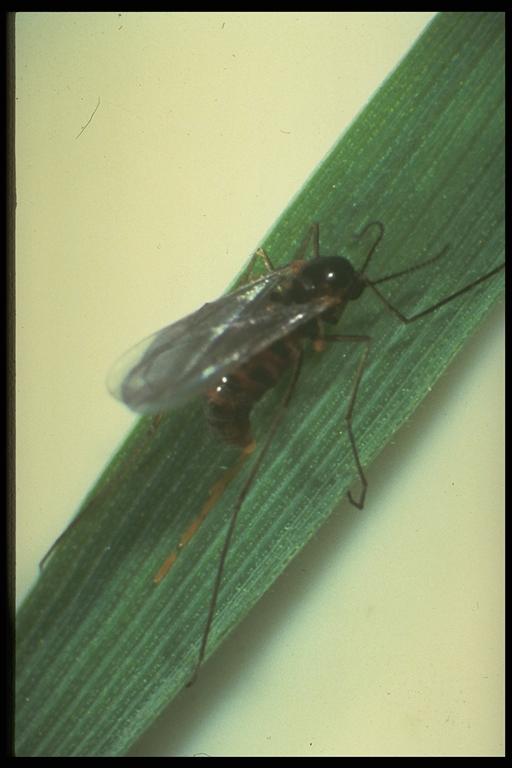
Hessian fly, Mayetiola destructor (Say) (Diptera: Cecidomyiidae), adult laying eggs. Photo by C. Hoelscher.
Common Name: Hessian fly
Scientific Name: Mayetiola destructor (Say)
Order: Diptera
Description: Eggs, although rarely seen, are thin, and cylindrical and laid along the veins of leaf sheaths. They are uniform glossy red when deposited, they turn a darker red at one end and opaque white at the other just before hatching. Spindle-shaped, legless larvae with no head capsules (maggots) are red for 4 to 5 days after hatching from the egg, and gradually turn white with a translucent green stripe down the back as they grow to 3/16 inch long. Puparia, most readily observed when dissecting infested plants, are 3/8 inch long, dark-brown and spindle-shaped, often called “flaxseed”, and contain the pupae. Adults are small (1/8 to 3/16 inch long), dark or red-tinged, gnat-like flies with long legs and antennae.
Life Cycle: Winter is spent in the pupal stage inside the puparium, just below the soil surface in the crown of the host plant. Adult flies emerge in spring and lay eggs on host plants. Larvae (maggots) hatch from eggs in 3 to 7 days, and develop through three stages (instars) over a period of 25 to 30 days before forming a puparium (by inflating the last larval skin). Summer is spent in field stubble. They are mainly active in the spring and fall, although there may be up to six generations per year.
Habitat and Food Source(s): Larvae (maggots) secrete enzymes that cause stems to exude sap on which the larvae feed. Hessian flies attack small grains, including wheat, rye, barley and some wild grasses. Larvae (maggots) in leaf sheath tissue at the crown or joints along the stem, rupture plant cells and feed on sap. Injured plants are stunted and may die or fall over (lodge) before harvest. Adults are most easily reared from the pupal stages by placing infested crowns in a plastic bag.
Pest Status: Larvae (maggots) burrow between leaf sheaths and remove plant sap from stems of small grain crops, causing injured plants to die, thereby reducing yield; occur from north central to central Texas; medically harmless.
For additional information, contact your local Texas AgriLife Extension agent or search for other state Extension offices.
Literature: Cameron et al. 1982.